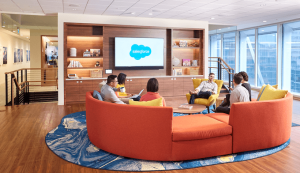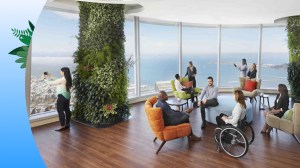A New Milestone in Sustainable Real Estate: Salesforce’s Journey to Healthy Materials and Leveraging Buying Power for Good




Matthew Buecher
Today we are releasing Healthier Materials in the Workplace: An Introductory Guide, which details our commitment to bringing healthier and sustainable materials into our workspaces. This represents an exciting moment in our sustainable real estate journey, where we can share successes, opportunities, and lessons learned about healthy materials with all of our stakeholders – our customers, partners, employees, peers, and the communities we support.
So what do we mean by Healthy Materials?
As part of Salesforce’s mission to create a more sustainable built environment, we launched the Salesforce Healthy and Sustainable Materials Program in early 2016 to understand, mitigate, and improve the environmental and health impacts of building products. Evaluating products’ health, environmental, and social attributes enables us to work with our partners and manufacturers to optimize products for health and sustainability before new products become integrated into the Salesforce Global Design Standards.
Prioritizing healthy materials in the built environment as an industry is still evolving but the evidence in relation to wellness continues to prove the benefits. There is still confusion about how to optimize for a healthy indoor environment while achieving certifications, collaborating with suppliers and remaining cost efficient. With so many standards, labels and certifications, it can be difficult to make sense of them and to truly understand which have more rigor than others. That’s why we are sharing how we created a structure, with the help of great partners like Brightworks Sustainability, to evaluate the materials that come through our doors to optimize for health and sustainability and how we intend to move the industry forward.
Living by our Values
When Salesforce was founded more than 20 years ago, our founders set out to build an entirely new kind of company. Guided by our core values – trust, customer success, innovation, and equality – we aim to provide an innovative product while showcasing that business can be the greatest platform for change.
We may have grown as a company over the years, but our commitment to building a culture of trust has never wavered. With trust being our number one value, we have a mission to not only deliver trusted products to our customers but also to ensure that all our stakeholders can trust us to do the right thing. The way we choose what products enter our workspaces is no different.
We create workspaces that are welcoming, trusted, and uniquely designed for the health and success of our Ohana. We want our employees and anyone who walks into Salesforce to trust that we’re providing them a healthy and sustainable place to work.
So, why Healthy Materials?
The built environment is growing rapidly and is present in all parts of our life. By 2060, over half the world’s population will live in urban environments, in buildings. In fact, the UN forecasts that 2.5 trillion square feet of buildings will be constructed over the next 40 years — that’s equivalent to building one New York City every 34 days. To build all of this requires a tremendous amount of raw materials, transportation, manufacturing, and eventually disassembly. How do we know what is in our building products? Who ensures the buildings we live, work, and play in are optimized for human health and well-being? Who examines the numerous synthetic chemicals that make up our flooring, ceilings, walls, tables, and chairs used in our spaces, to understand toxicity to humans? The answer may surprise you: nobody.
Back in 2016, as we prepared to build out Salesforce Tower, we recognized the need to address health in the built environment and understand why indoor environments can be highly polluted. After reviewing the numerous amounts of chemicals used across the industry, we recognized the imperative to act. Now nearly three years from the start of our healthy and sustainable materials journey, with the release of our Healthy Materials Manual, we aim to continue our commitment to environmental stewardship and offer a blueprint for how companies can begin to integrate healthier materials into their offices.
The Evolution of Healthy Materials
While we’re thrilled to be able to share this major milestone, we know we’re not done yet. This manual represents a snapshot in time and has already evolved since its original draft. In September of 2018, at the Global Climate Action Summit in San Francisco, we announced our next generation of climate commitments as part of the Step Up Declaration, which includes our commitment to a holistic green real estate strategy. All new major Salesforce workspaces established after 2020 will align with LEED Platinum v4 standards and pursue Zero Carbon Building certification through a focus on energy efficiency, impactful renewable energy procurement and the embodied carbon of building materials. As such, our next step in the evolution of our program will be to include the measurement of embodied carbon in the products we procure for our spaces.
Today’s announcement reinforces the notion that businesses can be powerful platforms for change. Through our healthy materials journey, we’ve learned businesses can be powerful drivers in the industry shift toward more healthy materials.
Our advice? Don’t be afraid to start. As you learn more, you’ll adapt, evolve and your program will become more rigorous. Start with asking suppliers a few select questions. And work with your peers to learn best practices. No one company can solve these complex and imperative issues alone, but together we can instigate great change.
To learn more about our sustainability programs and track our progress, visit salesforce.com/sustainability. We hope you join us on this journey!














